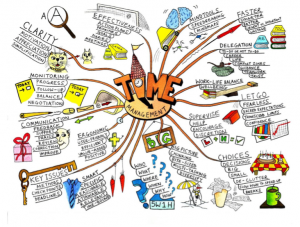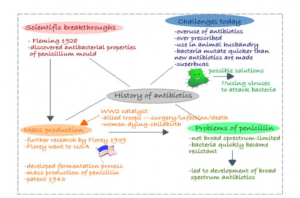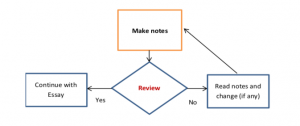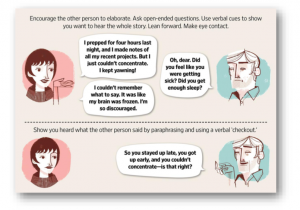Effective Note-Taking: Get the Most Out of Your Lessons
Why it is important to take notes? Note Taking…
- Helps in concentration
✓ In order to take notes – to write something sensible – you must understand the text - Helps in maintaining a permanent record of what you have read or listened to
✓ Useful for exam revision
Before the class
Research
- If you turn up at a lecture and haven’t got the slightest idea what it’s going to be about, you’ll be playing catch-up for the next hour. Find out what’s going to be covered and read around it first, then you can relax and get the expert’s opinion on the subject.
Have a list of questions prepared of items that you did not understand from the text.
- The lecturer might answer this through the lecture; however, in case he/she doesn’t you will have the questions on hand rather than trying to remember it.
During the class
Get to class early
- Arriving a few minutes early allows you time to pick a good spot, talk to classmates about assignments if clarification is needed and ask questions about the homework or previous night’s reading.
Sit near the front
- Choose a location near the front. It is somewhat true that individuals in the front a called on more which is a little more risky. However, this risk also provides one with motivation to “pay attention” and to have your reading assignments ready. Perhaps most importantly, sitting near the front minimizes distractions and improves your ability to focus on the lecture.
Take good notes
- Develop a system of effective note taking. Use abbreviations, symbols, or whatever you can do to get as much information as possible. Remember, writing things down word for word is time consuming and is rarely effective. It is more effective to “translate” the lecturer’s words into your own, as this forces you to process the information as you go. After class you can then fill in the blanks, write words out and fill in the blanks.
- If the lecturer provides the Power Point slides, DON’T skip taking notes. Taking your own notes is a form of learning that you miss out on if you just rely on the provided slides.
Ask Questions
- It is not expected that you should know all the material just from reading the book. If that were the case, we wouldn’t have lectures. Lecturers know that they will need to clarify. Go ahead and let them.
After the class
Complete your notes
- Ask classmates about any ideas you did not get or sections of your notes that you were unable to complete.
- Try and arrange to do this with a classmate after every lecture. Take 5 minutes and see if you can fill in all the blanks. Usually the lecturer will stick around for a few minutes to answer any lingering questions. Use this time to clean up your notes.
Review
- Make sure that when you are reviewing that you put everything in your own words. Review these notes at least once before you attend class again. Take time to review your notes at least once before your next class. A good time for this is just before you read the next assignment or chapter.
NOTE TAKING & ACTIVE LISTENING
Note Taking Techniques
– Linear
– Mind Mapping
– Flowchart
– Table
What is Linear Note Taking?
- Linear Note Taking is a technique where an outline of a given subject is created
- Outlining can follow different structures. A common structure uses bullet points to divide topics and sub-topics:
- First Main Topic
- Subtopic A
- Detail
- Detail
- Subtopic B
- Subtopic A
- Second Main Topic
- Subtopic
Linear Notes: Pros and Cons
Advantages
- Easy and quick to create notes
- No learning curve needed: easy technique to master
- Can be used to go into different levels of detail and use large bodies of text
Disadvantages
- Difficult to make connections between different topics
- Cannot visualize topics
- Cannot add information afterwards (pen & paper)
What is Mind Mapping?
- A mind map is a name given to a diagram that represents information relating to a topic visually
- Mind maps are generally built around a single concept which is represented at the centre of the map
- The mind map gives a holistic picture of the topic
- It is able to show the links between different concepts
An Example Mind Map Process
- Decide on the topic. The map starts in the centre with a representation of the topic
- Ideas associated with the topic are added to the map and connected to the map via lines
- Child ideas can be added to these branches. There is no limit to the number of branches that can be added
- The mind map can have a simple structure or can be highly creative in appearance with visuals used instead of, or to complement words


Mind Mapping: Pros and Cons
Advantages
- Versatile with broad applicability
- It is easy to add new thoughts and connections later on
- Can cover a large amount of information
- Can be personalized
Disadvantages
- Difficult to incorporate large bodies of text
- Time needed to master technique
- Time-consuming
Flowcharts
- Useful to show a sequence of events or a cause and effect relationship.

Tables
- Useful for comparing things, i.e. advantages and disadvantages.

What is Active Listening?
- A structured form of listening and responding that focuses the attention on the speaker
- The technique requires the listener to feedback what they have heard from the speaker, using their own words.
Active Listening in the Classroom
- Choose to find the subject useful.
- Concentrate on the words and message, not on the professor’s looks, clothes or delivery
- When you hear something, you’re not sure you agree with, react thoughtfully.
- Identify the “big ideas,” those fundamental concepts to which everything else in the lecture is related
- Stay attentive.
- Aggressively tackle difficult material.


Source: Wall Street Journal, Jan 2015

Source: Wall Street Journal, Jan 2015

Source: Wall Street Journal, Jan 2015
5 Phases of Active Listening
- Pick up on hints and messages that the person wants to talk
- Let the person disclose the problem. Acknowledge they have an issue. Don’t dismiss.
- Encourage the person to elaborate. Ask open-ended questions
- Paraphrase what you have heard
- Collaborate together on potential solutions
Active Listening in the Workplace
- Active Listening when used in the workplace is a technique that can reduce the number of errors and thus mean less wasted time
- Active listening is a powerful coaching and mentoring tool that enables managers to help employees find their own solutions to issues
- A Chinese symbol for “To Listen” is shown below. It is wise beyond the art. The left side of the symbol represents an ear. The right side represents the individual- you. The eyes and undivided attention are next and finally there is the heart.

- This symbol tells us that to listen we must use both ears, watch and maintain eye contact, give undivided attention, and finally be empathetic. In other words, we must engage in active listening!
 TOP
TOP